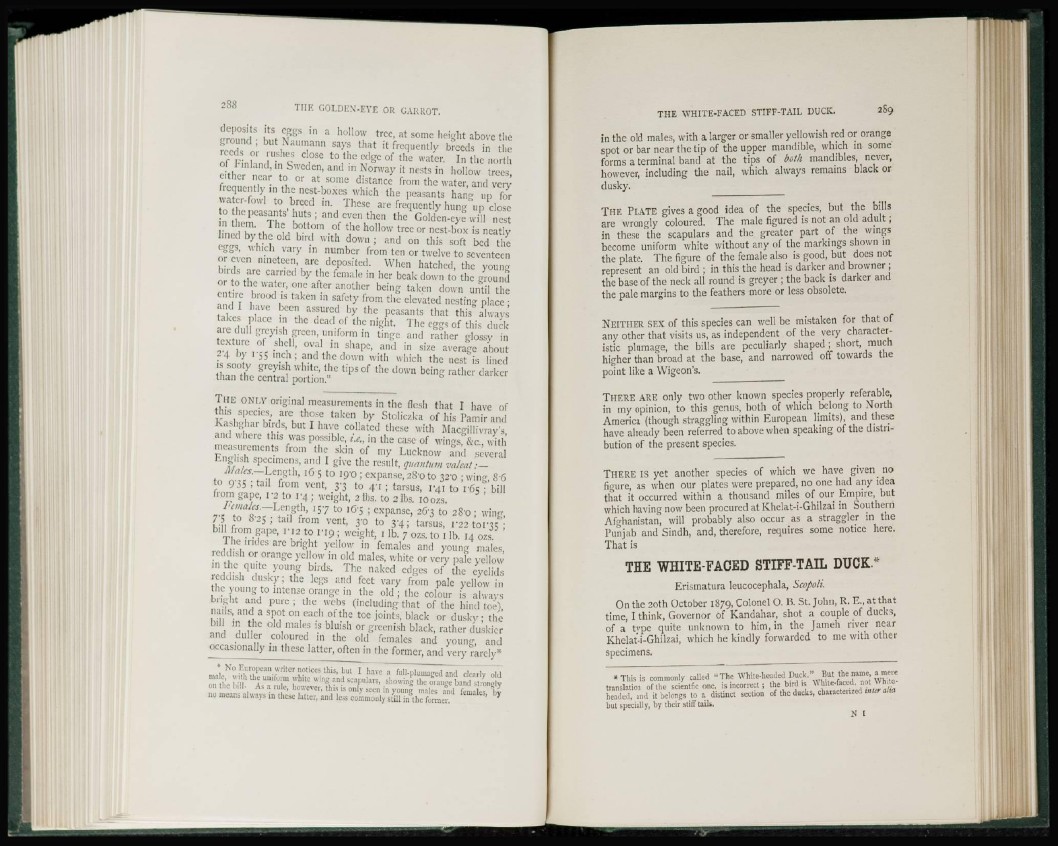
288 THE GOLDEN-EYE OR GARROT.
deposits its eggs in a hollow tree, at some height above the
ground ; but Kallmann says that it frequently breeds in the
reeds or rushes close to the edge of the water. In the north
of Finland, in Sweden, and in Norway it nests in hollow trees,
cither near to or at some distance from the water, and very
frequently in the nest-boxes which the peasants hang up for
water-fowl to breed in. These are frequently hung up close
to the peasants'huts ; and even then the Goldcn-cyc will nest
in them. The bottom of the hollow tree or nest-box is neatly
lined by the old bird with down ; and on this soft bed the
eggs, which vary in number from ten or twelve to seventeen
or even nineteen, arc deposited. When hatched, the young
birds are carried by the female in her beak down to the ground
or to the water, one after another being taken down until the
entire brood is taken in safety from the elevated nesting place ;
and I have been assured by the peasants that this always
takes place in the dead of the night. The eggs of this duck
arc dull greyish green, uniform in tinge and rather glossy in
texture of shell, oval in shape, and in size average about
24 by i-5 5 inch; and the down with which the nest is lined
is sooty greyish white, the tips of the down being rather darker
than the central portion."
T h e ONLY original measurements in the flesh that I have of
this species, are those taken by Stoliczka of his Pamir and
Kashghar birds, but I have collated these with Macgillivray's,
and where this was possible, i.e., in the case of wings, &c., with
measurements from the skin of my Lucknow and several
English specimens, and I give the result, quantum vahat: —
Mates.—Length, 16 5 to 19-0 ; expanse, 28'0 to 32*0 ; wing, S-6
to 935 ; tail from vent,-3 to 4'! ; tarsus, 1*41 to 165 ; bill
3
from gape, V2 to 1*4 ; weight, 2 lbs. to 2 lbs. ioozs.
Females.—Length, 157 to 165 ; expanse, 26*3 to 2S'0 ; wing,
7*5 to 8-25 ; tail from vent, 30 to 3*4; tarsus, 1*22 toi'35 ;
bill from gape, i'\2 to 1*19 ; weight, 1 lb. 7 ozs. to 1 lb. 14 ozs.
The irides arc bright yellow in females and young males,
reddish or orange yellow in old males, white or very pale yellow
in the quite young birds. The naked edges of the eyelids
reddish dusk)' ; the legs and fect vary from pale yellow in
the young to intense orange in the old; the colour is always
bright and pure ; the webs (including that of the hind toe),
nails, and a spot on each of the toe joints, black or dusky; the
bill in the old males is bluish or greenish black, rather duskier
and duller coloured in the old females and young, and
occasionally in these latter, often in the former, and very rarely*
* No European writer notices this, but I have a full-plumaged and clearly old
male, with the uniform white wing and scapulars, showing the orange band strongly
on the bill- As a rule, however, this is only seen in young males and females, by
no means always in these latter, and less commonly still in the former.
THE WHITE-FACED STIFF-TAIL DUCK. 289
in the old males, with a larger or smaller yellowish red or orange
spot or bar near the tip of the upper mandible, which in some
forms a terminal band at the tips of both mandibles, never,
however, including the nail, which always remains black or
dusky.
THE PLATE gives a good idea of the species, but the bills
are wrongly coloured. The male figured is not an old adult ;
in these the scapulars and the greater part of the wings
become uniform white without any of the markings shown in
the plate. The figure of the female also is good, but does not
represent an old bird ; in this the head is darker and browner ;
the base of the neck all round is greyer ; the back is darker and
the pale margins to the feathers more or less obsolete.
NEITHER SEX of this species can well be mistaken for that of
any other that visits us, as independent of the very characteristic
plumage, the bills are peculiarly shaped; short much
higher than "broad at the base, and narrowed off towards the
point like a Wigeon's.
THERE ARE only two other known species properly referable,
in my opinion, to this genus, both of which belong to North
America (though straggling within European limits), and these
have already been referred to above when speaking of the distribution
of the present species.
THERE IS yet another species of which we have given no
figure, as when our plates were prepared, no one had any idea
that it occurred within a thousand miles of our Empire, but
which having now been procured at Khelat-i-Ghilzai in Southern
Afghanistan, will probably also occur as a straggler in the
Punjab and Sindh, and, therefore, requires some notice here.
That is
THE WHITE-FACED STIFF-TAIL DUCK.4'
Erisrnatura leucocephala, Scopoli.
On the 20th October 1879, Colonel O. B. St. John, R. E., at that
time, I think, Governor of Kandahar, shot a couple of ducks,
of a type quite unknown to him, in the Jameh river near
Khelat-i-Ghilzai, which he kindly forwarded to me with other
specimens.
• T h i s is commonly called "The White-headed D u c k . " B u t the name a ^translation of the science one. is incorrect ; the bird is ^itZat*
headed, and it belongs to a distinct section of the ducks, characterized inter alia
but specially, by their stiff tail*.
N I